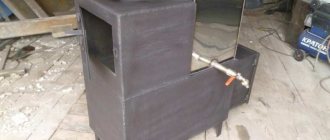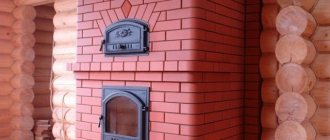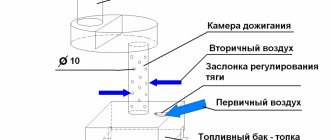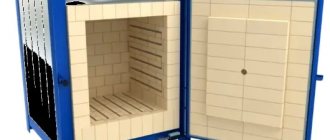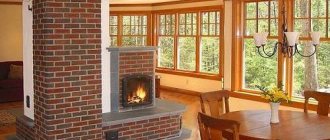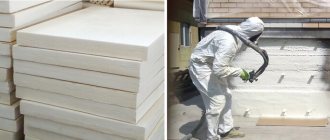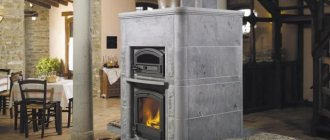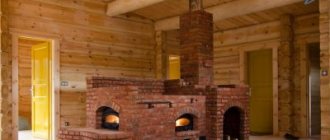How does a bell furnace work?
Before choosing this heating system as your main one, you need to understand how this stove works. The design of the kolapak furnace itself is small in size, which allows combustion products to move without obstacles.
- The main distinguishing feature of such a stove from conventional duct types is the smoke exhaust process.
- This process works by pushing out smoke and gas, which allows the stove to produce much more heat.
- This method of smoke exhaust also reduces the risk of fire blowing out, as well as the risk of carbon monoxide leakage, which can poison the human body.
In the designs of bell-type furnaces, two smoke exhausts play an important role, due to which high efficiency is achieved.
This is due to the fact that thermal energy is better accumulated. One chimney (external) performs the function of removing smoke outside, and the second is internal, which helps reduce the speed of movement of gases and remove them to the outside.
Basics
Most of the advantages of Kuznetsov furnaces come from the principle of free passage of gases. Let us explain again with an example.
Let's imagine a stove with a complex system of smoke ducts: an ethermark, a four-five-turn Dutch oven. In this cramped labyrinth, strong turbulence will inevitably arise. Have you heard the furnace humming? This is only a minor manifestation of the vortex energy raging within her. And there’s nowhere to get it from except from the fuel stash. If the channels are long and narrow enough, then at first glance there is nothing terrible here: the vortices, by the time they reach the pipe, will dissipate, cooling, and will still give their energy to the body of the furnace, and it to the room. But in reality, nuances appear, which will be discussed later in the text. Because of them, the efficiency of a channel furnace over 60% is an exceptional rarity.
In a channel stove, while it is being heated, a huge flow of energy rushes about, and only a small part of it can be used for heating or heating water without disturbing its operation. Such a furnace is somewhat similar to a nuclear reactor. Don’t be alarmed, just because of the synergy, i.e. along the paths of energy circulation in it. A nuclear reactor has to be loaded with tens of times more fuel than is necessary to ensure the design energy output. Otherwise, the neutrons will simply fly out without having time to meet the uranium atoms ready to receive them. In a channel furnace, hot vortices, without having time to cool, will fly out into the chimney or, conversely, will cool down immediately, producing smoke and soot.
But the Kuznetsovkas (details below) are closer in synergy to the thermonuclear reactors of the future. “Thermonylus” sounds scary, but this is only due to its association with the hydrogen bomb. In fact, fusion reactors are quite safe.
Why? Because they generate exactly as much energy as the consumer needs, and the technological power reserve required for rarefied plasma is scanty. If suddenly the chamber of a tokamak or stellarator suddenly completely collapses, the plasma will be completely emitted (there are no heavy atoms in it) and will cool down before it reaches the walls of the room. The repairmen will curse - maybe the duty department is sharpening their laces - but after 5 minutes. will be able to blunt to elimination without protective equipment.
So what do Kuznetsov furnaces have in common with thermonuclear reactors? The fact that the energy of the flue gases, thanks to the principle of free passage, does not rotate many times in the flow until it is pushed into the body of the furnace, but saturates it immediately. And now she has nowhere to go from there except into the room and/or the water heating register.
What bell furnace models are there?
It is worth noting that there are a lot of types of these furnaces, because each master has his own version of the furnace design. One of the most popular models are two-bell stoves, which differ from conventional ones by the presence of two hoods, one of which is located above the second.
Having a small size, this stove can be installed in small rooms, and the design of a bell-type stove with two bells is not very complicated.
There are other types of these furnaces, including:
- Bell-type ovens with a built-in chamber for making baked goods.
- Sauna bell stoves.
- Bell-type stoves, which are used only for space heating.
- Cooking bell furnaces, which are made of ceramic bricks.
- Cooking and heating furnaces.
- Bell-type stoves, which are equipped with a fireplace.
Construction options
Heating and cooking stoves for domestic use can be of several types according to their design.
Chamber
A metal chamber stove is a classic “potbelly stove”, which has been greatly improved in modern production. This unit has the following technical characteristics:
Channel
The principle of operation of this design: the gases burn out, and then cool and pass through the channels between the partitions, and give off heat to the furnace body. The unit must warm up to 400°C inside - then afterburning will occur in it. Modern potbelly stoves can easily be reclassified as a duct circuit. In this case, only a horizontal “elbow” is left from the flue and it separates the combustion chamber from the firebox.
Combustion air enters through the cracks of the hob or through a special air throttle. A duct stove has an efficiency of up to 80%, and the specific thermal power is several times greater than that of a chamber stove. Such a stove works both with long burning and with flame, on almost any fuel.
At the same time, the power is regulated by the air supply - this possibility here is 2 times higher than in a chamber potbelly stove. An advantage for household use is the temperature in the afterburner is within 250-300°C, and this is convenient for cooking.
Almost all metal household stoves with a power of up to 15 kW are created according to the scheme described above. The body is usually made of ordinary steel with a thickness of 4 mm or more, and the hob is made of cast iron or steel with a thickness of 8 mm or more.
Kolpakovaya
Finally, a bell furnace is a scheme in which gases are retained by the roof of the bell until complete combustion, and then they fall down and give off the remaining heat. Such designs provide more than 70% efficiency. This technology is also applicable to metal boilers, but here we had to abandon the flame - a metal cap simply will not absorb as much heat as it releases without overheating. Therefore, such stoves were switched to smoldering mode - this made it possible to increase the heat transfer time to 60 hours (with wood) or up to 30 days (with coal).
Long-burning metal stoves can be made with your own hands and operate on wood, coal, but not on wet fuel, since wet fuel does not smolder, no matter how much air you give it. If this is a special coal boiler, then it will not be able to work on wood - it simply will not “give out” the required efficiency. The body of such a boiler is made of simple steel, surrounded by a sealed gas jacket.
For example, you can trim the body at a distance of 70 mm with a hot water register in the form of a ring tank or coil. This will enhance convection and produce hot water. Such boilers are suitable for heating large houses (optionally, dachas, country cottages) with a bathroom, even in harsh climatic zones. User reviews of such stoves are positive.
How to prepare a place for the stove
To properly install such a stove, you need to carefully study the step-by-step installation instructions, features and recommendations. In general, this process consists of a preparatory stage, laying the first and second stages.
To properly install the stove, you will need some tools, including:
- Scoop and bayonet types of shovels.
- Reinforced metal rods.
- Formwork.
- Polyethylene film.
- Cement mortars.
- Sand material.
After preparing all the material and tools, you need to start preparing the place for the stove.
This process is carried out in several stages:
- Preparing a hole measuring one and a half meters by one meter, the depth should be eighty centimeters.
- Covering the bottom with sand material. The size of the layer of sand material should not exceed fifteen centimeters.
- After covering, the pit is left for two days to allow the sand materials to settle.
- Preparation of formwork, which is made from plywood or waste boards.
- Performing reinforcement using rods made of steel materials.
- Pouring cement mortar. It is necessary to distribute the solution evenly.
After all these activities, you need to leave it all for a certain period of time for the mortar and foundation to harden.
Vesuvius "Legend Retro 24 (DT 4)"
This small stove heats a room up to 26 m². Its design is quite simple, but laconic. Made entirely of cast iron, closed type. Safe to use, maintains room temperature for a long time. The device is installed permanently, lined with bricks, because there is no convector casing.
Characteristics:
- warms up a room of 12-26 m²;
- chimney duct with a diameter of 120mm;
- weight - 117 kg;
- size (D/W/H) - 795x660x660 mm.
Among the advantages, it is worth noting the affordable price, ease of use, durable materials, excellent build quality.
Of the minuses: it weighs a lot, the front door is cast iron, but this is not a minus for everyone.
Reviews
Vladimir, 29 years old
“I have a steam room of 15 sq.m., it warms up quickly, it takes about 25 minutes. You can put in a good amount of firewood at a time and you have to add less wood.”
How to lay out the oven
The process of laying out stoves is a very important stage of the entire installation process, because the stability and efficiency of the stove will depend on it. The laying is carried out in two levels. At the first, you will need a solution for which you will need clay and water, a steel plate, and bricks made of refractory materials.
In addition, you will need a grinder with special attachments for stone materials, a drill with a hammer attachment and a grate.
The masonry process at the first level consists of:
- Laying a layer of alphabet on the foundation.
- Laying bricks on a layer of alphabet.
- Laying the second row of bricks, placing blowers and cleaning windows.
- Making partitions for the lower and upper compartments.
- Laying refractory bricks and installing a series of beams.
- Laying out the fireplace insert for the sixth row.
- Laying out the smoke exhaust in the seventh row.
- Laying out a special compartment for the firebox made of refractory bricks in the ninth row.
- Laying out gratings in the twelfth row.
- Making a ceiling made of refractory bricks to block access to the chimney.
- Closing all pipe passages with steel plates.
After completing the first level activities, you need to move on to the second, here you need:
- Lay out the oven roof.
- Close the exits to the chimneys.
- Install steam traps.
- Create a hood.
- Install a plate that serves as an intake and cover it with bricks.
- Lay out chimneys with a diameter of one brick.
Main manufacturers
Let's look at the most popular manufacturers on the modern metal furnace market.
Teplodar
Teplodar - model “Vertical” (increased long-burning mode gives 8 hours of heating without adding fuel), “Stove” is equipped with a hob with removable rings, “Top Model” and “Matrix” can act as a fireplace due to fireproof glass in the doors , from where the flame is visible. The T-80 model can be equipped with a smoke exhaust.
The stoves of this manufacturer are designed to heat houses with an area of 80-300 m3, and the cost is scattered within 10-25 thousand rubles.
Ephel and Bayard
Efel is a Belgian manufacturer that leads the European home heating technology market. Thus, the “Harmony” model has a power of 12.5 kW and runs on wood and coal with a burning duration of 10 hours. That is, the oven can work all night.
Pros and cons of bell-type furnaces
Before installing such stoves, you need to study the list of advantages and disadvantages.
Among the advantages are:
- Cost-effective materials.
- The installation process is simple, because the design does not require a complex mechanism, and the laying process does not require additional skills.
- Easy to use. These stoves require almost no maintenance, and there are no special requirements for fuel materials.
- Fast and efficient heating due to its design.
- Possibility to make a stove in any design.
The disadvantages include:
- Uneven heating of the oven.
- Limited design options.
- High fuel consumption.
Features of operation
The difference between Kuznetsov stoves is that they do not require special care and are very easy to operate. For them, it is enough only to prepare the appropriate dry solid fuel (firewood) in the required quantity.
Since the efficiency of a bell-type stove is very high, the consumption of firewood will be much less than in conventional stoves that we are used to.
In bell-type furnaces, virtually no soot is formed, since it is spent on secondary combustion and an increase in thermal energy.
- Before using the oven, it must be thoroughly dried. To do this, you need to heat it 2 times a day, one hour and a half at a time, with a small amount of fuel. The ash and furnace doors must be open.
- It is not recommended to use large amounts of wood chips and cardboard for kindling. Only for a short time they will give the maximum temperature, which will lead to cracking of the bricks.
- To light the stove, it is best to use paper, torches or birch bark. This will remove cold air from the chimney pipe, create the necessary draft and obtain a firewood burning temperature of about 350°C. In winter, if the stove has not been used for a long time, it is recommended to do the kindling with the “summer” valve open.
- After combustion begins, firewood must be placed in the combustion chamber in order to obtain a maximum operating temperature of 800–900°C.
Bell-type stoves practically do not need cleaning, and if the need arises, it is best to seek help from professional stove makers. They will quickly and efficiently clean the chimney, firebox, grate and other elements of the stove.
Photo of a bell-type stove for heating a house or bathhouse
Vesuvius "Sensation 16 Anthracite (270)"
It has a large ash pan; the closed heater can hold up to 60 kg of stones. There is a cooling and self-cleaning system. High quality durable coating. Included in the TOP 5 “Best stoves for Russian baths”.
Characteristics:
- warms the room up to 18 m³;
- chimney duct with a diameter of 120 mm;
- weight - 99 kg;
- size (D/W/H) - 640x410x690 mm.
Reviews
Maxim, 54 years old
“I decided to change the stove; the previous one lasted 15 years. On the advice of a friend, I bought Vesuvius Sensation 16 Anthracite. Easy to maintain, everything is provided. I don’t regret buying it.”
Operating principle
Before the bell-type system began to be used for heating a house, ducted structures were most in demand. The heated air along with the exhaust gases rose up the channel, heating its walls. Next, the smoke entered the chimney and was discharged outside due to the action of artificial draft.
Note! The system heated unevenly and cooled quickly, which after some time caused the integrity of the masonry to be compromised. Another disadvantage of this method was the large amount of soot formed.
When a bell-type stove operates, the hot air moves on its own: it is pushed out by a new portion of gas. In fact, any such system is a two-bell furnace, since it always contains two bells, which are either next to each other or above each other. Hot gases are retained in them. Both cavities are connected by a jumper through which hot air circulates.
KASTOR Karhu 16 JK
A small, lightweight device perfectly warms up the steam room and maintains the temperature well. Finnish stove made of alloy cast iron. Has a box for ash and secondary combustion.
Characteristics:
- warms the room up to 16 m³;
- chimney duct with a diameter of 104 mm;
- weight 59 kg;
- size (H/W/D) - 710x435x490 mm.
Reviews
Oleg, 44 years old
“In 2022 we decided to change the stove, we chose KASTOR, we’ve been using it for three years now, it’s like new. It heats great. I recommend".
When choosing a stove, the buyer should pay attention to his needs and the characteristics of the room. How will you install? What are the possibilities? A cast iron stove for a bath is an ideal option both in price and in operation. We have presented to you the “TOP 10 Best Cast Iron Sauna Stoves”, now the choice is yours!
Vesuvius "Legend Lux"
It has a power of up to 30 kW, which allows you to heat rooms up to 28 m³. The thickness of the firebox walls is 12 mm! The capacity of the heater is 180 kg, you can get excellent steam. There is a convenient ash pan and a glass self-cleaning system. Keeps warm for a very long time.
Characteristics:
- warms the room up to 28 m³;
- chimney duct with a diameter of 115mm;
- weight - 137 kg;
- size (D/W/H) - 760x560x780 mm.
Reviews
Vladislav, 35 years old
“We chose it as a gift for our parents at the dacha. On the advice of the seller, we bought this stove. And they were right, it heats perfectly, firewood is used sparingly. The parents are happy."
Hephaestus "ZK 18 (M)"
The device has powerful steam generation, which is ideal for a Russian bath. The heater has a capacity of 18 m³, there is a recess for additional steam, and there are heat-removing spikes on the lower part. All this increases the heating area and contributes to its speed.
Characteristics:
- warms the room up to 18 m²;
- chimney duct with a diameter of 115 mm
- weight - 166 kg;
- size (H/W/D) - 538x393x478 mm;
Reviews
Vladimir, 52 years old
“I have a steam room of 12 sq.m., it warms up very quickly, with the old one I had to wait several hours. Great model."
Ermak “20 Mesh standard” (cast iron)
The firebox and body are made of cast iron. This firebox is for those who value aesthetics. There is a mesh for stones, but the stove itself is of the closed type, which is safer. An overhead connection to the chimney duct is provided. Suitable for heating large steam rooms. Easy to buy, always in stock.
Characteristics:
- warms the room up to 20 m²;
- chimney duct with a diameter of 115 mm;
- weight 115 kg;
- size (D/W/H) - 800x540x920 mm.
Reviews
Alexander, 37 years old
“After reading the reviews, I decided to choose this option. Installation took a little time, it doesn't cool down for a long time. My wife still has time to do the laundry.”
NARVI Oy Kota Inari
You can find this model in the “Best stoves for wood-burning saunas” rating. Large, stationary, open-type stove for burning wood. Walls made of thick-walled cast iron, an ash pan, heat-resistant glass and low cost, what could be better?
Characteristics:
- warms the room up to 16 mm³;
- chimney duct with a diameter of 119 mm;
- weight - 94 kg;
- size (H/W/D) - 770x550x550 mm.
Reviews
Ilya, 47 years old
“It’s easy and quick to drown. We needed a firebox for a small large steam room. This is the best choice."

